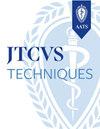Modified bio-Bentall operation with a rapid deployment valve
IF 1.9
Q3 CARDIAC & CARDIOVASCULAR SYSTEMS
引用次数: 0
Abstract
Objective
To evaluate the early outcomes of a modified bio-Bentall operation using a rapid deployment valve (RDV) in high-risk patients, focusing on procedural efficacy, survival rates, and complications.
Methods
A retrospective review of 11 consecutive patients who underwent the modified bio-Bentall operation with an RDV between January 2018 and December 2022 was conducted. Kaplan–Meier survival analysis was used to determine survival rates. Patients' baseline characteristics, operative details, and postoperative outcomes were reviewed.
Results
The median patient age was 71 years. Most patients presenting with high-risk conditions and significant comorbidities, including inflammatory conditions, chronic lung diseases, and advanced cardiac dysfunction. The median EuroSCORE II was 10.03%. The median aortic cross-clamping and cardiopulmonary bypass times were 73.0 minutes and 99.0 minutes, respectively. No early mortalities or reoperations occurred. Two patients (14.3%) required extracorporeal membrane oxygenation support because of low cardiac output and arrhythmias, and 3 patients (23.1%) required permanent pacemaker insertion. No paravalvular leakage or valve detachment was observed during follow-up. The 1-year survival rate was 90.9%, and the 3-year survival rate was 54.5%. Six patients died during a median follow-up of 35 months, from causes including respiratory complications, gastric cancer, and undetermined factors.
Conclusions
Our initial experience with the modified bio-Bentall operation using an RDV shows favorable early outcomes in relatively high-risk patients. Further validation with larger datasets and long-term follow-up is needed to validate these results.
改进的生物本特尔操作与快速部署阀
目的评价采用快速部署瓣膜(RDV)进行改良生物-本特尔手术治疗高危患者的早期疗效、生存率和并发症。方法回顾性分析2018年1月至2022年12月连续11例行改良生物本特尔手术的RDV患者。采用Kaplan-Meier生存分析确定生存率。回顾了患者的基线特征、手术细节和术后结果。结果患者中位年龄为71岁。大多数患者表现出高风险状况和显著的合并症,包括炎症、慢性肺部疾病和晚期心功能障碍。EuroSCORE II的中位数为10.03%。主动脉交叉夹持和体外循环的中位时间分别为73.0分钟和99.0分钟。无早期死亡或再手术发生。2例(14.3%)患者因低心排血量和心律失常需要体外膜氧合支持,3例(23.1%)患者需要永久植入起搏器。随访期间未见瓣旁渗漏或瓣膜脱离。1年生存率为90.9%,3年生存率为54.5%。在平均35个月的随访期间,有6名患者死亡,死因包括呼吸系统并发症、胃癌和未确定因素。结论采用RDV改良生物本特尔手术的初步经验表明,相对高危患者早期预后良好。需要用更大的数据集和长期随访来进一步验证这些结果。
本文章由计算机程序翻译,如有差异,请以英文原文为准。
求助全文
约1分钟内获得全文
求助全文

 求助内容:
求助内容: 应助结果提醒方式:
应助结果提醒方式:


